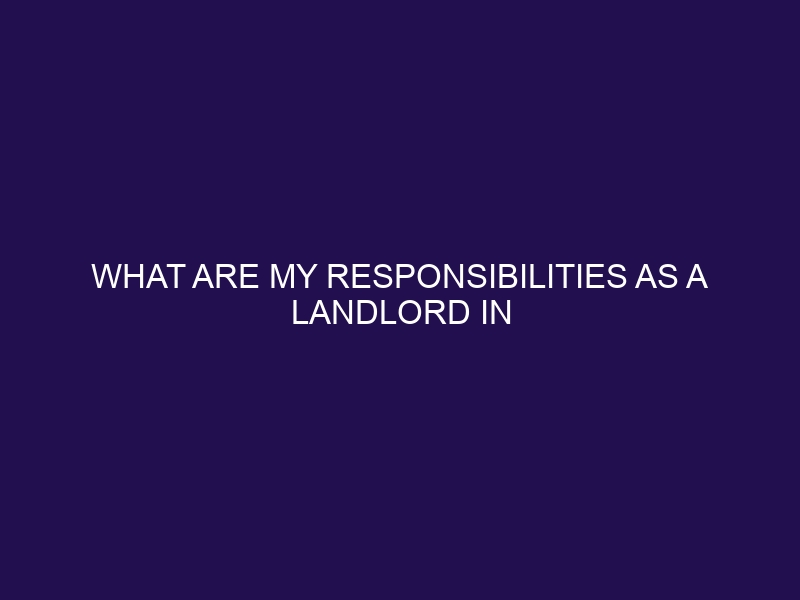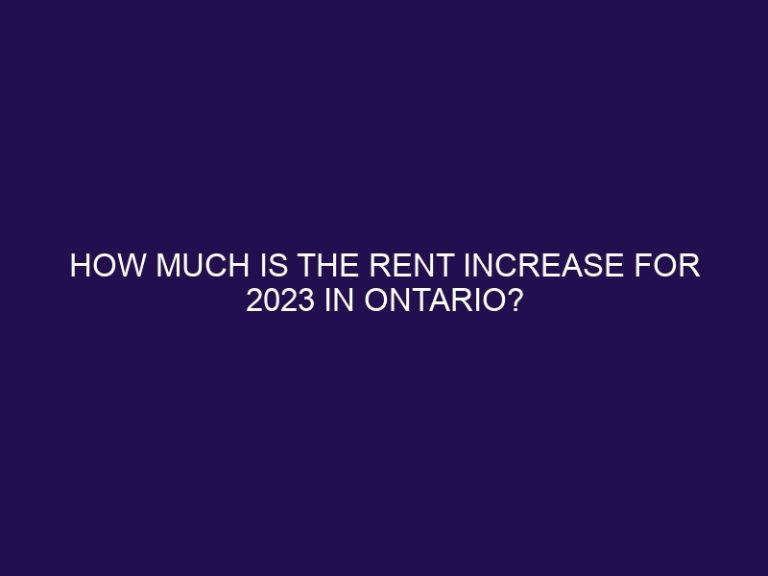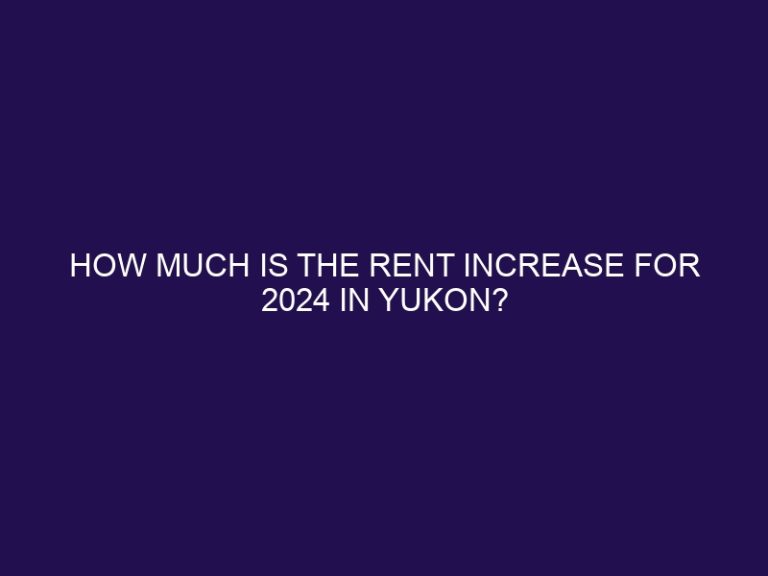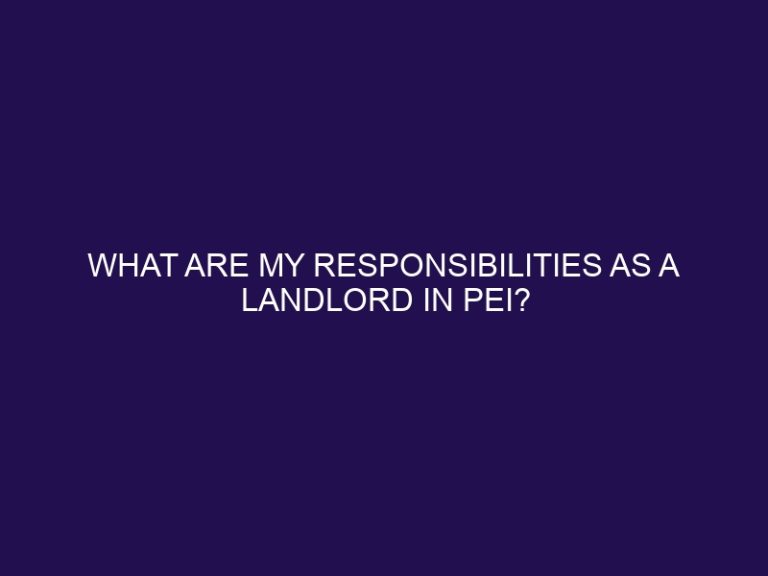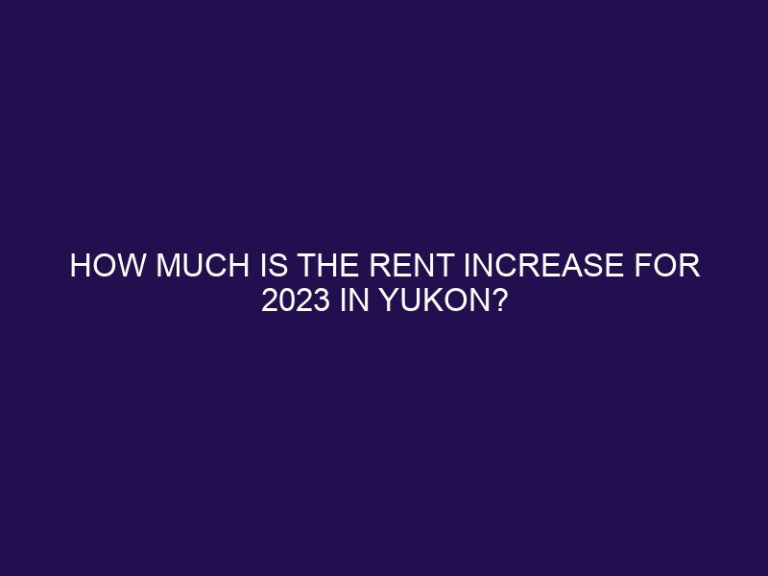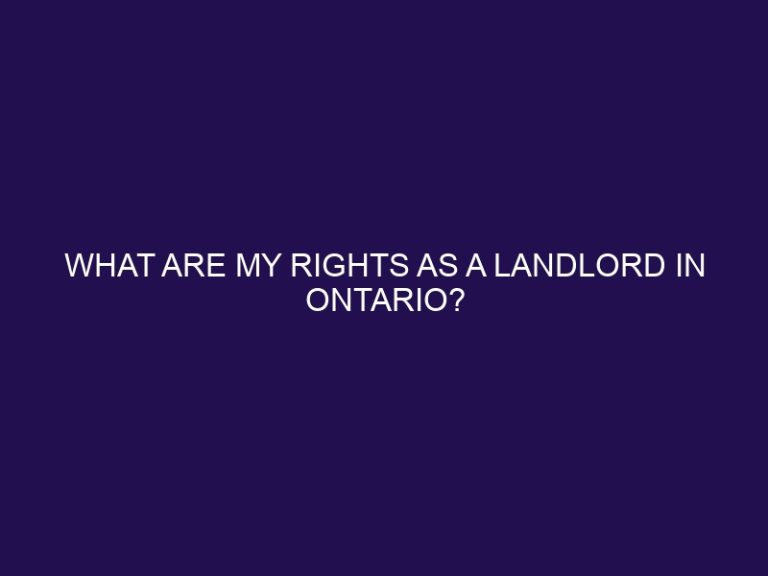What are my responsibilities as a landlord in Manitoba?
.jpg)
Understanding the Role of a Landlord is crucial when renting out a property in Manitoba. As a landlord, you have specific responsibilities and obligations that you must fulfill to ensure a positive renting experience for both you and your tenants. It is important to familiarize yourself with the legal framework and regulations in Manitoba to avoid any potential conflicts or legal issues.
A landlord is the owner or manager of a rental property who leases it to tenants in exchange for rent. Landlords in Manitoba have several legal obligations that they must adhere to. These include providing a safe and habitable living environment, maintaining the property, adhering to rental agreements and lease contracts, collecting rent and security deposits, respecting tenant privacy, and handling tenant complaints and disputes.
Rental agreements and lease contracts play a vital role in clarifying the rights and responsibilities of both landlords and tenants. It is essential to include key terms and conditions in these agreements, such as the rental term, rent amount, payment terms, and rules regarding pets, smoking, and maintenance responsibilities.
Maintaining the rental property is another essential responsibility of a landlord. This includes ensuring habitability and providing basic amenities, as well as handling repairs, maintenance, and pest control issues promptly and efficiently.
Collecting rent and security deposits correctly is crucial for maintaining a healthy landlord-tenant relationship. Landlords must set and collect rent as per the agreed terms, and it is essential to understand the regulations governing security deposits to ensure compliance.
Respecting tenant privacy is vital. Landlords must provide advance notice and follow proper procedures when entering the rental unit for inspections, repairs, or other valid reasons.
Lastly, landlords must also be prepared to handle tenant complaints and disputes effectively. It is important to address issues amicably and find mutually acceptable resolutions. In case of unresolved disputes, landlords must be familiar with the legal procedures for eviction if necessary.
By understanding these responsibilities, landlords in Manitoba can ensure a positive and legally compliant rental experience for both themselves and their tenants.
Key takeaway:
- Understanding landlord responsibilities: Landlords in Manitoba have legal obligations to provide habitable living conditions, perform necessary repairs and maintenance, and respect tenant privacy.
- Rental agreements and leases: A comprehensive rental agreement should include key terms and conditions, such as rent amount, duration, and responsibilities of both landlord and tenant.
- Collecting rent and security deposits: Landlords need to set and collect rent on time while following regulations regarding security deposits to ensure a fair and transparent rental process.
Understanding the Role of a Landlord
Understanding the role of a landlord is vital for ensuring a successful and lawful landlord-tenant relationship. As a landlord in Manitoba, comprehending your specific responsibilities is of utmost importance. These responsibilities encompass providing secure and habitable living conditions, upholding the property, respecting tenant privacy, and adhering to the lease agreement’s terms. Additionally, it is crucial to have a thorough understanding of the provincial laws and regulations governing landlord-tenant relationships in Manitoba. By comprehending your role and fulfilling your obligations, you can establish a positive and mutually beneficial rental experience for both you and your tenants.
Fact: According to the Residential Tenancies Branch of Manitoba, landlords must furnish tenants with a written agreement that clearly delineates the tenancy’s terms and conditions.
What is a Landlord?
A landlord is a person who owns a property and rents it out to tenants in exchange for payment. Landlords, also known as property owners, have legal obligations that must be met, such as maintaining the property, ensuring habitability, and providing basic amenities. Additionally, landlords are responsible for handling repairs and maintenance responsibilities. They also have the crucial task of setting and collecting rent from tenants and abiding by security deposit regulations. Respecting tenant privacy and following proper procedures for entering the rental unit are essential aspects of being a landlord.
In the event of tenant complaints and disputes, landlords should always strive to resolve issues amicably, promoting open communication and fair resolution. If necessary, landlords must also be familiar with the legal procedures for eviction. It is crucial for landlords to understand their legal obligations and fulfill them diligently to have a successful experience as a property owner.
I once had a friend who ventured into the role of a landlord for the first time. Through her experience, she quickly realized the importance of comprehending her legal obligations and actively maintaining the rental property she owned. She faced various challenges, including promptly handling repairs and effectively dealing with tenant complaints. However, by maintaining open lines of communication and diligently keeping records, she was able to successfully address issues and ensure a positive tenant experience. The role of a responsible and knowledgeable landlord requires dedication, ongoing learning, and a commitment to fulfilling legal obligations.
What are the Legal Obligations of a Landlord?
The legal obligations of a landlord include providing a safe and habitable living environment, maintaining the property, handling repairs and maintenance, respecting tenant privacy, setting and collecting rent, following security deposit regulations, and addressing tenant complaints and disputes in a fair and timely manner. Additionally, landlords must ensure that the rental property meets health and safety standards and provides basic amenities. To fulfill their legal obligations, it is important for landlords to familiarize themselves with local laws and regulations. A pro-tip for landlords is to document all communication and agreements with tenants to avoid misunderstandings or legal issues in the future.
Rental Agreements and Lease Contracts
Creating Rental Agreements and Lease Contracts is an essential part of being a landlord in Manitoba. Here are some key aspects to consider when drafting these documents:
- Duration: Specify the length of the Rental Agreement or Lease Contract, whether it’s a fixed term or month-to-month.
- Rent: Clearly state the amount, due date, and accepted payment methods in the Rental Agreement or Lease Contract.
- Utilities and Maintenance: Outline who is responsible for paying utilities and maintaining the property in the Rental Agreement or Lease Contract.
- Rules and Policies: Include any rules regarding pets, smoking, noise, or other specific regulations in the Rental Agreement or Lease Contract.
- Termination: Establish the conditions under which the Rental Agreement or Lease Contract can be terminated by either party.
The Rental Agreements and Lease Contracts serve as legally binding documents that protect both landlords and tenants and ensure a clear understanding of expectations.
What Should be Included in a Rental Agreement?
A rental agreement is a crucial document that outlines what should be included in a rental agreement. It includes the terms and conditions of renting a property, ensuring a clear understanding between the landlord and tenant(s). Here are some essential elements to naturally incorporate in a rental agreement:
- Names of the landlord and tenant(s)
- Property details, including address and description
- Duration of the lease and renewal clauses
- Rental terms, including the amount, due date, and accepted payment methods
- Security deposit amount and conditions for its return
- Responsibilities for repairs and maintenance
- Rules and regulations, such as pet policies and noise restrictions
- Conditions for termination of the lease
- Signatures of all parties involved
True story: A few years ago, my friend rented an apartment without a written rental agreement. This caused numerous issues, such as disputes over rent payments and conflicting understandings of tenant responsibilities. To avoid such complications, it is essential to have a clear and detailed rental agreement in place.
What Are the Key Terms and Conditions?
The key terms and conditions in a rental agreement are crucial for both landlords and tenants to understand their rights and responsibilities. Here is a breakdown of some essential elements:
| Number | Name | Description |
|---|---|---|
| 1. | Rent Amount | Clearly state the monthly rent and when it is due. |
| 2. | Lease Term | Specify the duration of the lease, whether it’s month-to-month or a fixed term. |
| 3. | Security Deposit | Outline the amount and conditions for refunding the deposit. |
| 4. | Maintenance Responsibilities | Clarify who is responsible for repairs and maintenance. |
| 5. | Utilities | Specify which utilities the tenant is responsible for paying. |
| 6. | Occupancy Limits | Define the number of occupants allowed in the rental unit. |
| 7. | Pet Policies | Outline any restrictions or policies regarding pets. |
| 8. | Termination Clause | Specify the notice period required for both parties to terminate the lease. |
By including these key terms and conditions, both landlords and tenants can ensure a clear and mutually beneficial rental agreement.
Maintaining the Rental Property
As a landlord in Manitoba, one of your crucial responsibilities lies in maintaining the rental property. In this section, we’ll explore the various aspects of this responsibility. From ensuring habitability and basic amenities to taking care of repairs and maintenance, we’ll cover it all. We’ll delve into how landlords deal with pest control issues. So, buckle up and get ready to learn how to keep your rental property in top-notch condition for your tenants.
Ensuring Habitability and Basic Amenities
Ensuring habitability and basic amenities is crucial for landlords in a rental property. This involves:
- Regularly inspecting the property to ensure it meets health and safety standards.
- Providing clean and functional utilities such as water, electricity, heating, and ventilation.
- Maintaining proper sanitation facilities, including plumbing and waste management systems.
- Addressing any pest infestations promptly and effectively.
- Ensuring that common areas and shared facilities are well-maintained and accessible to tenants.
- Responding promptly to repair requests and resolving any issues that may arise.
A well-maintained and habitable rental property not only keeps tenants happy but also helps to attract and retain quality tenants in the long run.
Fun Fact: Did you know that in some jurisdictions, landlords may be required by law to provide certain amenities such as smoke detectors, carbon monoxide alarms, and fire extinguishers to ensure the safety of their tenants?
Repairs and Maintenance Responsibilities
Ensuring proper repairs and maintenance is a key responsibility of a landlord. Here are some important aspects to consider:
Pro-tip: Establishing open lines of communication with tenants can help identify and address repair and maintenance needs more efficiently.
Dealing with Pest Control
Dealing with pest control is an essential responsibility for landlords to ensure the comfort and health of their tenants. Here are some steps to effectively handle pest control:
- Identify the pest: Determine the type of pest infestation present in the rental property.
- Consult professionals: Seek advice from pest control experts for professional inspection and treatment.
- Take preventive measures: Implement preventive actions like sealing cracks, removing food sources, and regular cleaning.
- Notify tenants: Inform tenants about the pest issue, sharing instructions on how they can contribute to pest prevention.
- Schedule treatments: Arrange regular pest control treatments to address infestations and prevent future problems.
- Document communication: Maintain records of all pest control discussions and actions taken for future reference.
Remember, open communication and prompt action are key to effectively manage pest control in rental properties. Make sure to prioritize the well-being and comfort of your tenants.
Collecting Rent and Security Deposits
When it comes to being a landlord in Manitoba, understanding the ins and outs of collecting rent and security deposits is crucial. In this section, we’ll dive into two key aspects: setting and collecting rent, and navigating security deposit regulations. Discover how to effectively manage rental income and ensure compliance with local laws to protect yourself and your tenants. Let’s explore these essential responsibilities in detail.
Setting and Collecting Rent
Setting and collecting rent as a landlord requires careful consideration and adherence to legal requirements. To ensure a smooth process, follow these steps:
- Research market rates to determine a fair and competitive rent price for your property.
- Set the rental terms, including the payment due date, late fees, and acceptable payment methods.
- Screen potential tenants to assess their financial stability and their ability to pay rent on time.
- Create a written rental agreement that outlines all the terms and conditions.
- Collect the rent on the agreed-upon date and provide the tenants with receipts for their records.
- Maintain detailed records of all rent payments and communication with tenants.
Pro-tip: To streamline the rent collection process and improve tenant satisfaction, consider offering convenient online payment options.
Understanding Security Deposit Regulations
Understanding security deposit regulations is essential for landlords to ensure compliance with the law and protect their interests. Here are key aspects to consider:
1. Familiarize yourself with the legal requirements: It is crucial to understand the local and state laws governing security deposits. Take note of the maximum allowable amount, whether it needs to be held in an interest-bearing account, and the timeframe for returning the deposit.
2. Provide proper documentation: As a landlord, it is important to give tenants a written receipt and a detailed statement that clearly outlines the amount and purpose of the security deposit. Communicate any deductions made and provide reasons for them.
3. Protect the security deposit: Safeguard the security deposit in a separate account and refrain from using it for personal expenses. Some jurisdictions may even require you to inform tenants about the specific location where the deposit is held.
4. Follow the appropriate return process: When it comes to returning the security deposit, make sure to follow the necessary procedures. Keep receipts for any repairs or cleaning and deduct only reasonable expenses. Additionally, provide a written explanation if you decide to withhold part of the deposit.
Understanding and adhering to security deposit regulations not only ensures legal compliance but also fosters trust and maintains positive landlord-tenant relationships.
Tenant Privacy and Entry
When it comes to being a landlord in Manitoba, understanding tenant privacy and entry is crucial. In this section, we’ll dive into the importance of respecting tenant privacy and the necessary procedures for entering a rental unit. Discover how maintaining a balance between privacy and responsible management plays a significant role in establishing a positive landlord-tenant relationship. So, let’s explore the key considerations and guidelines that every landlord should keep in mind to ensure utmost respect for tenant privacy while fulfilling their responsibilities.
Respecting Tenant Privacy
- Respecting tenant privacy is a crucial responsibility for landlords. Here are some key considerations to keep in mind:
- Establish clear guidelines: Include privacy provisions in the rental agreement to outline the tenant’s right to privacy and specify when and how the landlord may enter the rental unit.
- Provide proper notice: Give tenants reasonable notice before entering their unit, typically 24-48 hours, except for emergencies or specific circumstances outlined in local laws.
- Respect personal space: When entering the unit, respect the tenant’s personal belongings and privacy. Avoid unnecessary intrusion and maintain professionalism.
- Handle sensitive information: Ensure that tenant information, such as social security numbers and financial records, is protected and securely stored to maintain privacy.
Procedures for Entering the Rental Unit
To maintain tenant privacy and uphold legal obligations, landlords must follow proper procedures for entering the rental unit. These steps ensure respectful and lawful entry:
By following these procedures for entering the rental unit, landlords can uphold tenant rights, maintain a positive landlord-tenant relationship, and ensure a smooth rental experience.
Dealing with Tenant Complaints and Disputes
As a landlord in Manitoba, dealing with tenant complaints and disputes can be a challenging aspect of property management. In this section, we will explore effective strategies for resolving issues amicably, ensuring a harmonious landlord-tenant relationship. We will delve into the legal procedures for eviction, offering insight into the necessary steps to take when more serious disputes arise. So, let’s navigate the tenant complaint and dispute landscape to ensure a smooth and compliant rental experience in Manitoba.
Resolving Issues Amicably
Resolving issues amicably is crucial for maintaining a healthy landlord-tenant relationship. Here are some steps to help navigate and resolve conflicts peacefully:
- Keep communication open: Encourage tenants to promptly share their concerns or issues.
- Listen empathetically: Understand their perspective and validate their feelings.
- Find common ground: Seek mutually agreeable solutions that address the needs of both parties.
- Mediation: Consider involving a neutral third party to facilitate productive discussions.
- Put agreements in writing: Document any resolutions reached to avoid misunderstandings later.
Pro-tip: Creating a positive and respectful atmosphere can foster open lines of communication and prevent conflicts from escalating.
Legal Procedures for Eviction
- Legal procedures for eviction involve several steps that landlords in Manitoba must follow to regain possession of their rental property.
- Serve Notice: Provide written notice to the tenant, citing the specific grounds for eviction as outlined in the Residential Tenancies Act.
- File an Application: If the tenant refuses to vacate, the landlord must file an eviction application with the Residential Tenancy Branch.
- Attend the Hearing: Both the landlord and the tenant will attend a hearing where they present their cases to the Residential Tenancy Branch adjudicator.
- Obtain an Eviction Order: If the adjudicator grants an eviction order, the landlord can proceed with removing the tenant from the premises.
- Enforce the Eviction Order: The landlord can then engage the local sheriff’s office to enforce the eviction order and remove the tenant.
Following these legal procedures ensures that landlords in Manitoba adhere to the law when evicting tenants.
Some Facts About “What are my responsibilities as a landlord in Manitoba?”:
- ✅ Landlords in Manitoba are responsible for ensuring the rental property meets health, safety, and maintenance standards. (Source: Residential Tenancies Branch)
- ✅ Landlords must provide tenants with written tenancy agreements that include important information such as rent amount, payment due dates, and rules related to the rental property. (Source: Residential Tenancies Branch)
- ✅ It is the landlord’s responsibility to promptly address repairs and maintenance issues reported by tenants. (Source: Residential Tenancies Branch)
- ✅ Landlords are required to provide advance notice to tenants before entering the rental unit for non-emergency reasons, such as repairs or inspections. (Source: Residential Tenancies Branch)
- ✅ In Manitoba, landlords must follow specific rules and procedures when evicting tenants, including giving proper notice and obtaining an order of possession from the Residential Tenancies Branch if necessary. (Source: Residential Tenancies Branch)
Frequently Asked Questions
What are my responsibilities as a landlord in Manitoba?
As a landlord in Manitoba, you have several responsibilities. Before entering into a tenancy agreement, it is important to review the fact sheets provided by the Residential Tenancies Branch. These fact sheets cover topics such as tenancy agreements, condition reports, deposits, guarantee agreements, and privacy. Familiarizing yourself with these resources will help ensure that you fulfill your obligations as a landlord.
What should I do during a tenancy?
During a tenancy, it is essential to stay informed and prepared. The Residential Tenancies Branch offers forms that can be used by landlords to address various situations that may arise. These forms include those related to repairs, rent increases, bed bug information, and subletting. By utilizing these resources, you can effectively manage your rental property and maintain a positive relationship with your tenants.
What should I do if the tenant does not pay rent?
If a tenant fails to pay rent, the Residential Tenancies Branch provides fact sheets and forms to guide you through the process of addressing non-payment of rent. These resources can help you give notice to the tenant, terminate the tenancy if necessary, and pursue any outstanding rent owed. It is important to follow the proper procedures outlined by the Residential Tenancies Branch to ensure a fair resolution to the issue.
What resources are available for new landlords?
The Residential Tenancies Branch offers a range of resources to assist individuals interested in becoming landlords. Before purchasing a property, it is recommended to review the fact sheets and forms provided. These resources cover topics such as becoming a landlord, before you buy, landlords’ own use, giving notice, guarantee agreements, application for rent increase above the guideline, and new tenant information. By familiarizing yourself with these resources, you can start your journey as a landlord on the right foot.
What should I do when ending a tenancy?
When ending a tenancy, it is important to follow the proper procedures to ensure a smooth transition. The Residential Tenancies Branch offers fact sheets on various scenarios, such as giving notice for the landlord’s own use, demolition, renovation, change of use, non-payment of rent, and sale of property. Additionally, there are forms available for landlords to use in these situations, such as termination notices for non-payment of rent, termination notices for tenant services charges, termination notices for mobile homes, and termination notices for causes other than non-payment of rent. By utilizing these resources, you can effectively navigate the process of ending a tenancy.
What should I know about bed bug information and change of use as a landlord?
As a landlord, it is important to be proactive in addressing bed bug infestations and potential changes in property use. The Residential Tenancies Branch provides fact sheets on bed bug information and change of use. These resources can help you understand your responsibilities in preventing and addressing bed bug infestations, as well as the regulations surrounding changes in property use. By following the guidelines provided, you can maintain a safe and compliant rental property.

